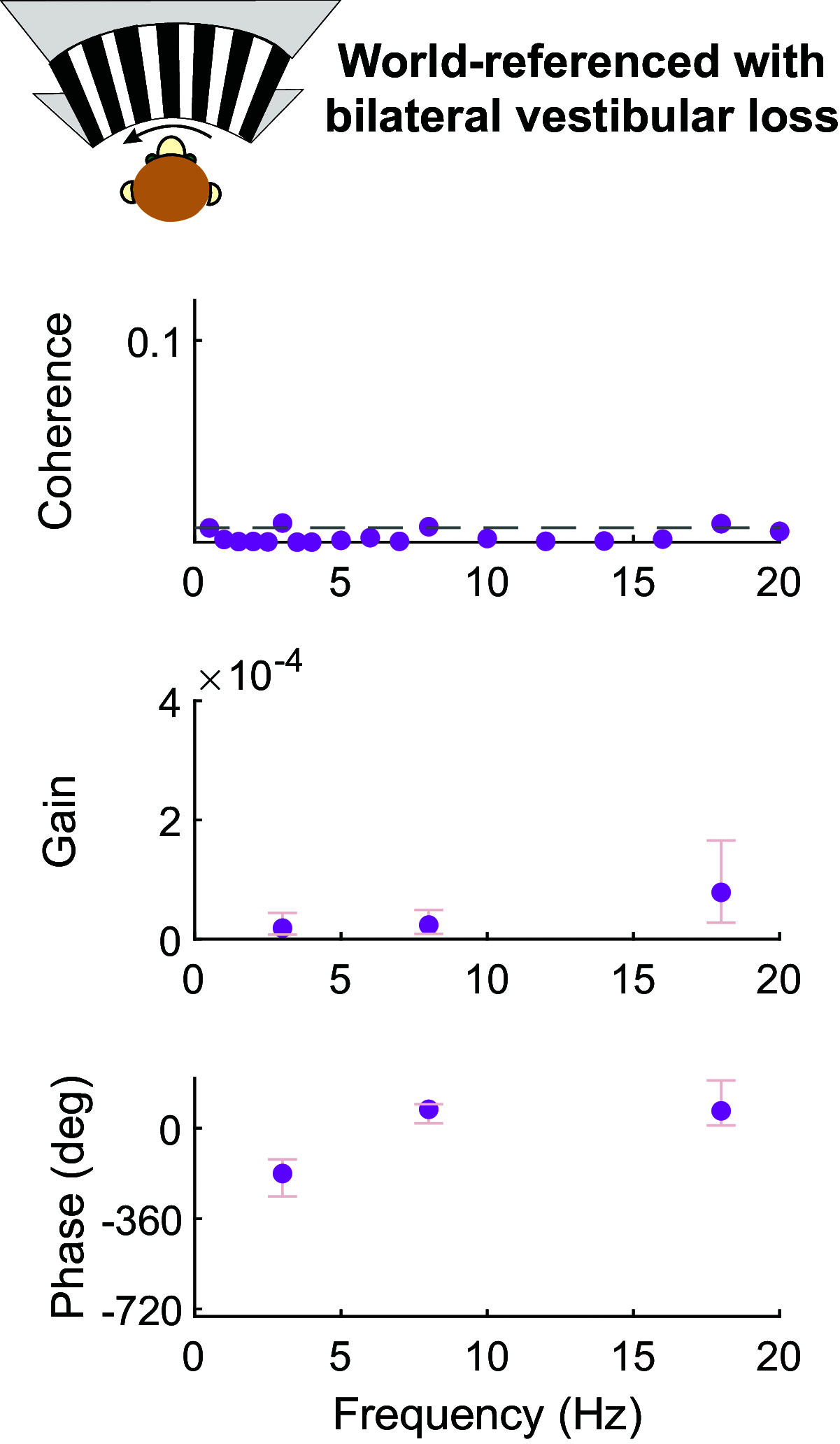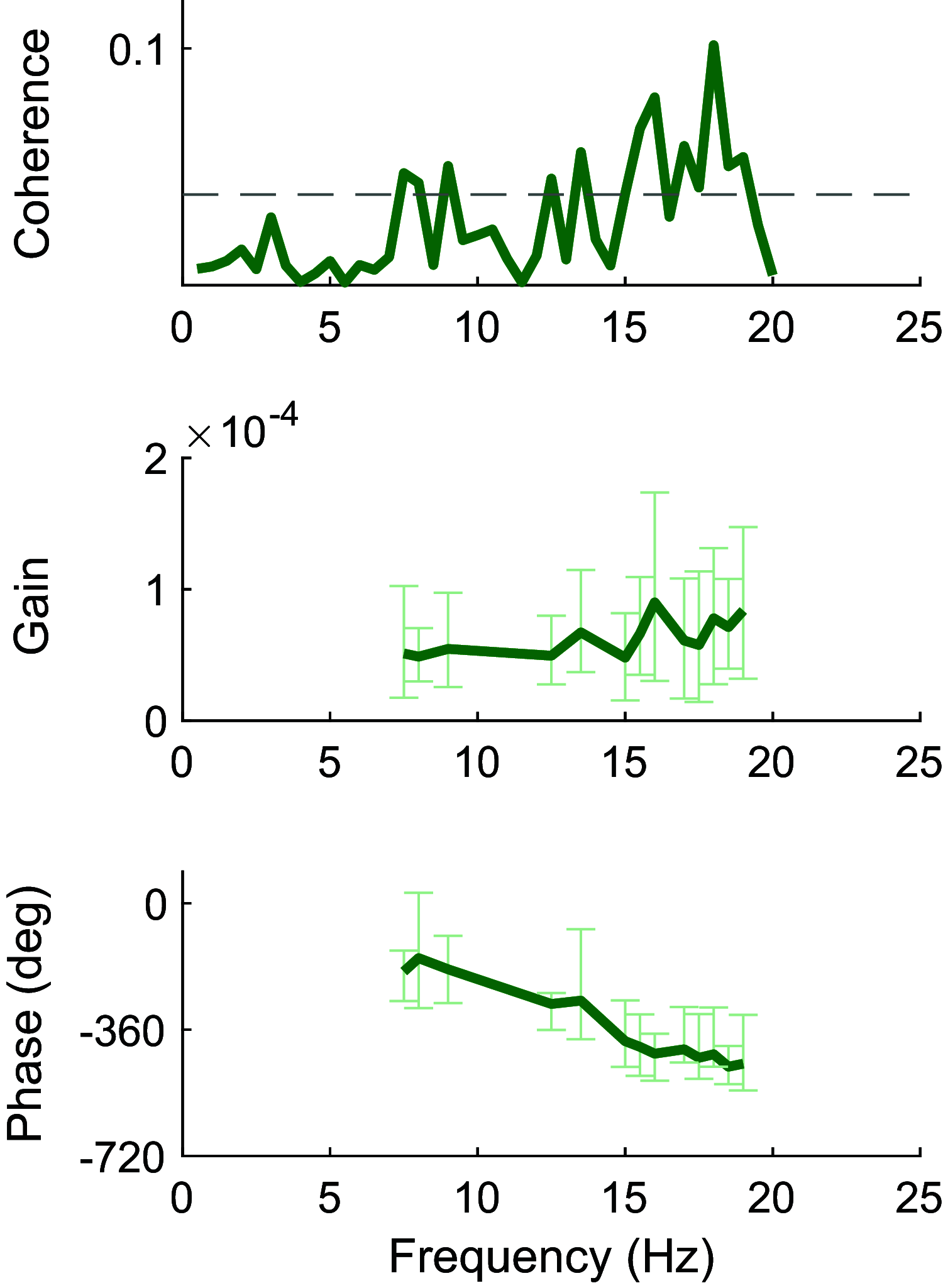Vestibular Contributions to Primate Neck Postural Muscle Activity during Natural Motion
- PMID: 36801822
- PMCID: PMC10072293
- DOI: 10.1523/JNEUROSCI.1831-22.2023
Vestibular Contributions to Primate Neck Postural Muscle Activity during Natural Motion
Abstract
To maintain stable posture of the head and body during our everyday activities, the brain integrates information across multiple sensory systems. Here, we examined how the primate vestibular system, independently and in combination with visual sensory input, contributes to the sensorimotor control of head posture across the range of dynamic motion experienced during daily life. We recorded activity of single motor units in the splenius capitis and sternocleidomastoid muscles in rhesus monkeys during yaw rotations spanning the physiological range of self-motion (up to 20 Hz) in darkness. Splenius capitis motor unit responses continued to increase with frequency up to 16 Hz in normal animals, and were strikingly absent following bilateral peripheral vestibular loss. To determine whether visual information modulated these vestibular-driven neck muscle responses, we experimentally controlled the correspondence between visual and vestibular cues of self-motion. Surprisingly, visual information did not influence motor unit responses in normal animals, nor did it substitute for absent vestibular feedback following bilateral peripheral vestibular loss. A comparison of muscle activity evoked by broadband versus sinusoidal head motion further revealed that low-frequency responses were attenuated when low- and high-frequency self-motion were experienced concurrently. Finally, we found that vestibular-evoked responses were enhanced by increased autonomic arousal, quantified via pupil size. Together, our findings directly establish the vestibular system's contribution to the sensorimotor control of head posture across the dynamic motion range experienced during everyday activities, as well as how vestibular, visual, and autonomic inputs are integrated for postural control.SIGNIFICANCE STATEMENT Our sensory systems enable us to maintain control of our posture and balance as we move through the world. Notably, the vestibular system senses motion of the head and sends motor commands, via vestibulospinal pathways, to axial and limb muscles to stabilize posture. By recording the activity of single motor units, here we show, for the first time, that the vestibular system contributes to the sensorimotor control of head posture across the dynamic motion range experienced during everyday activities. Our results further establish how vestibular, autonomic, and visual inputs are integrated for postural control. This information is essential for understanding both the mechanisms underlying the control of posture and balance, and the impact of the loss of sensory function.
Keywords: motor unit; natural motion; neck muscle; postural control; vestibular; vestibulocollic.
Copyright © 2023 the authors.
Figures










Similar articles
-
Vestibulocollic reflexes in the absence of head postural control.J Neurophysiol. 2014 Oct 1;112(7):1692-702. doi: 10.1152/jn.00343.2014. Epub 2014 Jul 9. J Neurophysiol. 2014. PMID: 25008409 Free PMC article.
-
Transformation of Vestibular Signals for the Control of Standing in Humans.J Neurosci. 2016 Nov 9;36(45):11510-11520. doi: 10.1523/JNEUROSCI.1902-16.2016. J Neurosci. 2016. PMID: 27911755 Free PMC article.
-
Sound-evoked vestibular projections to the splenius capitis in humans: comparison with the sternocleidomastoid muscle.J Appl Physiol (1985). 2019 Jun 1;126(6):1619-1629. doi: 10.1152/japplphysiol.00711.2018. Epub 2019 Mar 28. J Appl Physiol (1985). 2019. PMID: 30920883
-
Vestibular signals in primate cortex for self-motion perception.Curr Opin Neurobiol. 2018 Oct;52:10-17. doi: 10.1016/j.conb.2018.04.004. Epub 2018 Apr 23. Curr Opin Neurobiol. 2018. PMID: 29694922 Review.
-
Vestibular contributions to high-level sensorimotor functions.Neuropsychologia. 2017 Oct;105:144-152. doi: 10.1016/j.neuropsychologia.2017.02.004. Epub 2017 Feb 2. Neuropsychologia. 2017. PMID: 28163007 Review.
Cited by
-
Sensorimotor Transformations for Postural Control in the Vermis of the Cerebellum.J Neurosci. 2025 May 21;45(21):e0249252025. doi: 10.1523/JNEUROSCI.0249-25.2025. J Neurosci. 2025. PMID: 40399043 Review.
-
Effect of vestibular loss on head-on-trunk stability in individuals with vestibular schwannoma.Sci Rep. 2024 Feb 12;14(1):3512. doi: 10.1038/s41598-024-53512-3. Sci Rep. 2024. PMID: 38347021 Free PMC article.
-
Reference Frames for Encoding of Translation and Tilt in the Caudal Cerebellar Vermis.J Neurosci. 2025 Mar 12;45(11):e0135242025. doi: 10.1523/JNEUROSCI.0135-24.2025. J Neurosci. 2025. PMID: 39933930
-
Habituation of vestibular-evoked balance responses after repeated exposure to a postural threat.J Physiol. 2025 Mar;603(6):1567-1587. doi: 10.1113/JP287391. Epub 2025 Feb 21. J Physiol. 2025. PMID: 39982119 Free PMC article.
-
Human proprioceptive gaze stabilization during passive body rotations underneath a fixed head.Sci Rep. 2024 Jul 29;14(1):17355. doi: 10.1038/s41598-024-68116-0. Sci Rep. 2024. PMID: 39075206 Free PMC article.
References
-
- Amjad AM, Halliday DM, Rosenberg JR, Conway BA (1997) An extended difference of coherence test for comparing and combining several independent coherence estimates: theory and application to the study of motor units and physiological tremor. J Neurosci Methods 73:69–79. 10.1016/S0165-0270(96)02214-5 - DOI - PubMed
-
- Berthoz A, Anderson JH (1971) Frequency analysis of vestibular influence on extensor motoneurons: II. Relationship between neck and forelimb extensors. Brain Res 34:376–380. - PubMed
MeSH terms
Grants and funding
LinkOut - more resources
Full Text Sources
